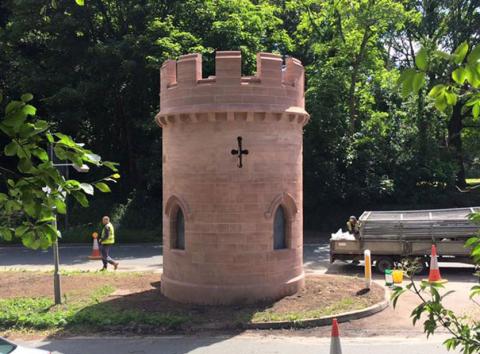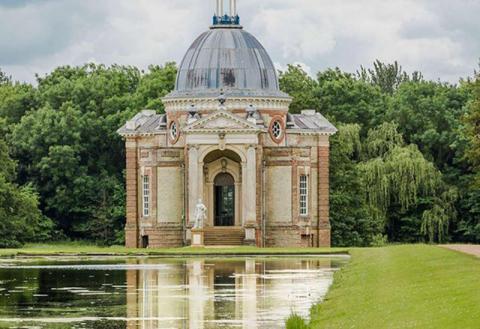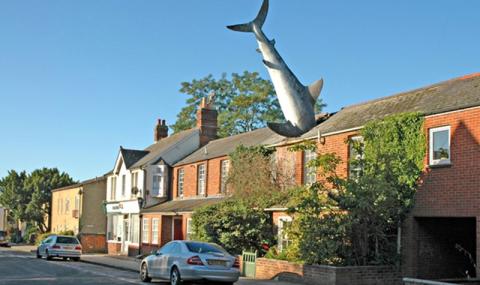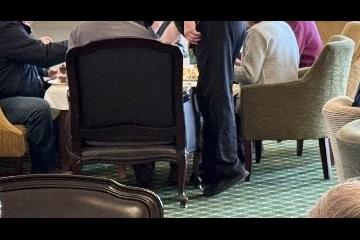We regret that the visit to the Towner Gallery on 3 February (see December 2025 newsletter) is now sold out.
For the Love of Follies
For the Love of Follies
18 Jan 2021
For the Love of Follies
“Form follows function” is a maxim many modern architects swear by. Yet, for the designers of flashy and usually pointless structures, one part of that equation was left out. In architecture, a folly is a decorative building that doesn’t serve much of a practical purpose, even if it’s meant to look like it does. They can be found all over the world, and range from crumbling (fake) ruins to a tropical fruit-themed greenhouse. Here are some English architectural follies whose style overshadows their substance.
Sandiway Tower – a Grade II listed iconic landmark on the A556 – was completely demolished after a car smashed into it in November 2013. Two years of campaigning by an enthusiasticc local pressure group and an insurance settlement has ensured the tower was rebuilt even though it is functionless and sits on a island in the middle of a dual carriageway. Originally it formed part of a gate lodge to the house of Vale Royal Abbey and last occupied (as a residence) in the 1920s. Other lodge buildings were demolished when the main road was converted into a four-lane dual carriageay in the 1930s. It is now rented out as a holiday let (presumably with easy vehicluar access?)
Sandiway Tower, Cheshire (Image: Cllr Charles Fifield) source: Cheshire Live website https://www.cheshire-live.co.uk/news/chester-cheshire-news/restoration-sandiway-round-tower-finally-9678982
Described as “Hampshire’s finest folly", Peterson’s Tower at Sway is the biggest, the most impressive and the oddest. Andrew Thomas Turton Peterson was born in Yorkshire in 1813 and died in London in 1906. In the intervening 93 years he ran away to sea, became a lawyer, went to India, made a fortune, retired to Hampshire, became a Spiritualist, and built Peterson’s Tower - the first major building in Britain to be built from concrete. Even if it isn’t the tallest folly in the country, its 218ft and 13 storeys make it spectacular by any standards. It is held by most to be undeniably ugly and the stories about the ghost of Sir Christopher Wren inspiring its design, the rumours that Peterson was buried at the top of the tower, and its total unsuitability for the New Forest make it an even more compelling building.
The leading family in the Bedfordshire of the mid-1700s were the Greys of Wrest Park near Silsoe. Henry Grey, the twelfth Earl of Kent, was created Duke of Kent in 1710, at the time that Thomas Archer was building him a magnificent banqueting house in the grounds of Wrest Park. It has been accepted by the architectural establishment in its own right (as a folly) being “huge, virtually useless, ostentatious and wildly expensive”. It is held to be the finest individual building in Bedfordshire, built to a complicated plan based on Borromini’s Sant’Ivo alla Sapienza in Rome. Contemporary observers described it as “frightful”
Wrest Park Pavilion, Source: English Heritage https://www.english-heritage.org.uk/visit/places/wrest-park/
Around 1746, the Needle’s Eye, a slender pyramid about 45ft high in Wentworth, W. Yorks, was built with a tall ogee arch and a flamboyant urn on top. The most memorable factor behind this folly, one of the finest in Britain, is the legend of how it came to be built. The story runs that, one night, the inebriated Earl Fitzwilliam accepted a wager that he could not “drive a carriage through the eye of a needle”. The following morning, sober, he realised the difficulty of completing the challenge so, in an expensive solution, he constructed a narrow arch just wide enough to allow a coach through and called it “The Needle’s Eye”. It is not known if the legend is true. There is evidence of that suggests the building was used for execution by firing squad or target practice, as one side bears several distinct musket-ball marks.
Finally – while not a building per se, an ‘intervention’ to an existing structure can qualify in the folly-stakes ….
The Hedington Shark, Oxford (photo credit: The Guardian)
Just off the High Street in Hedington, east of Oxford, is a row of terraced houses, undistinguished apart from the 25ft basking shark which has plummeted through the roof of number two and become transfixed in an upstairs bedroom.
Bill Heine, a cinema owner who had a chat show on Radio Oxford, was the bane of local councillors. He built it in 1986 and claimed it was a sculpture – as works of art were not subject to planning permission – and even changed the name of his house to “Plinth”. When questioned on why he had done it, he said: “The shark was to express someone feeling totally impotent and ripping a hole in their roof out of a sense of impotence and anger and desperation. It is saying something about CND, nuclear power, Chernobyl and Nagasaki.”
And …
Just when you thought it was safe to go back in the loft … Hedington’s famous shark house has been offered for rent. The property is being advertised at £519 ($826) a week, or £2,250 ($3,583) a month, and is being marketed at families or mature students. The advert suggests that it might be: “suitable for a family who are passionate about being involved with the local community and who will enjoy not only living in but living with the famous Hedington shark,” adding (with no sense of irony) “sorry no pets”….
The Hedington Shark, Oxford (photo credit: The Guardian)
About the Author
Jeni Fraser
JOIN OUR MAILING LIST
Become an instant expert!
Find out more about the arts by becoming a Supporter of The Arts Society.
For just £20 a year you will receive invitations to exclusive member events and courses, special offers and concessions, our regular newsletter and our beautiful arts magazine, full of news, views, events and artist profiles.
FIND YOUR NEAREST SOCIETY
MORE FEATURES
What a welcome! Coffee and cake at the Hydro Hotel!!!
Following the success of our Winter Study Day at the Hydro Hotel in November, we are delighted to announce that our S






